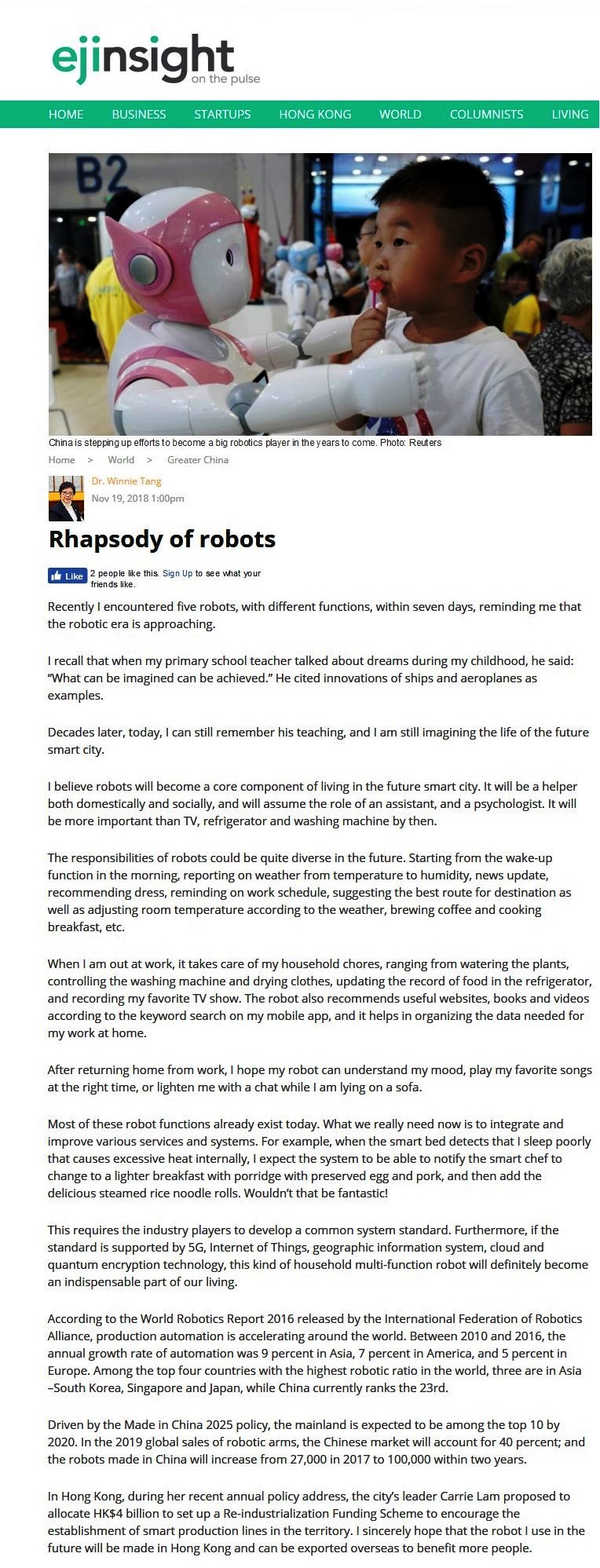網上版請按此

Rhapsody of robots
Recently I encountered five robots, with different functions, within seven days, reminding me that the robotic era is approaching.
I recall that when my primary school teacher talked about dreams during my childhood, he said: "What can be imagined can be achieved." He cited innovations of ships and aeroplanes as examples.
Decades later, today, I can still remember his teaching, and I am still imagining the life of the future smart city.
I believe robots will become a core component of living in the future smart city. It will be a helper both domestically and socially, and will assume the role of an assistant, and a psychologist. It will be more important than TV, refrigerator and washing machine by then.
The responsibilities of robots could be quite diverse in the future. Starting from the wake-up function in the morning, reporting on weather from temperature to humidity, news update, recommending dress, reminding on work schedule, suggesting the best route for destination as well as adjusting room temperature according to the weather, brewing coffee and cooking breakfast, etc.
When I am out at work, it takes care of my household chores, ranging from watering the plants, controlling the washing machine and drying clothes, updating the record of food in the refrigerator, and recording my favorite TV show. The robot also recommends useful websites, books and videos according to the keyword search on my mobile app, and it helps in organizing the data needed for my work at home.
After returning home from work, I hope my robot can understand my mood, play my favorite songs at the right time, or lighten me with a chat while I am lying on a sofa.
Most of these robot functions already exist today. What we really need now is to integrate and improve various services and systems. For example, when the smart bed detects that I sleep poorly that causes excessive heat internally, I expect the system to be able to notify the smart chef to change to a lighter breakfast with porridge with preserved egg and pork, and then add the delicious steamed rice noodle rolls. Wouldn't that be fantastic!
This requires the industry players to develop a common system standard. Furthermore, if the standard is supported by 5G, Internet of Things, geographic information system, cloud and quantum encryption technology, this kind of household multi-function robot will definitely become an indispensable part of our living.
According to the World Robotics Report 2016 released by the International Federation of Robotics Alliance, production automation is accelerating around the world. Between 2010 and 2016, the annual growth rate of automation was 9 percent in Asia, 7 percent in America, and 5 percent in Europe. Among the top four countries with the highest robotic ratio in the world, three are in Asia –South Korea, Singapore and Japan, while China currently ranks the 23rd.
Driven by the Made in China 2025 policy, the mainland is expected to be among the top 10 by 2020. In the 2019 global sales of robotic arms, the Chinese market will account for 40 percent; and the robots made in China will increase from 27,000 in 2017 to 100,000 within two years.
In Hong Kong, during her recent annual policy address, the city's leader Carrie Lam proposed to allocate HK$4 billion to set up a Re-industrialization Funding Scheme to encourage the establishment of smart production lines in the territory. I sincerely hope that the robot I use in the future will be made in Hong Kong and can be exported overseas to benefit more people.
Dr. Winnie Tang
Honorary Professor, Department of Computer Science, The University of Hong Kong